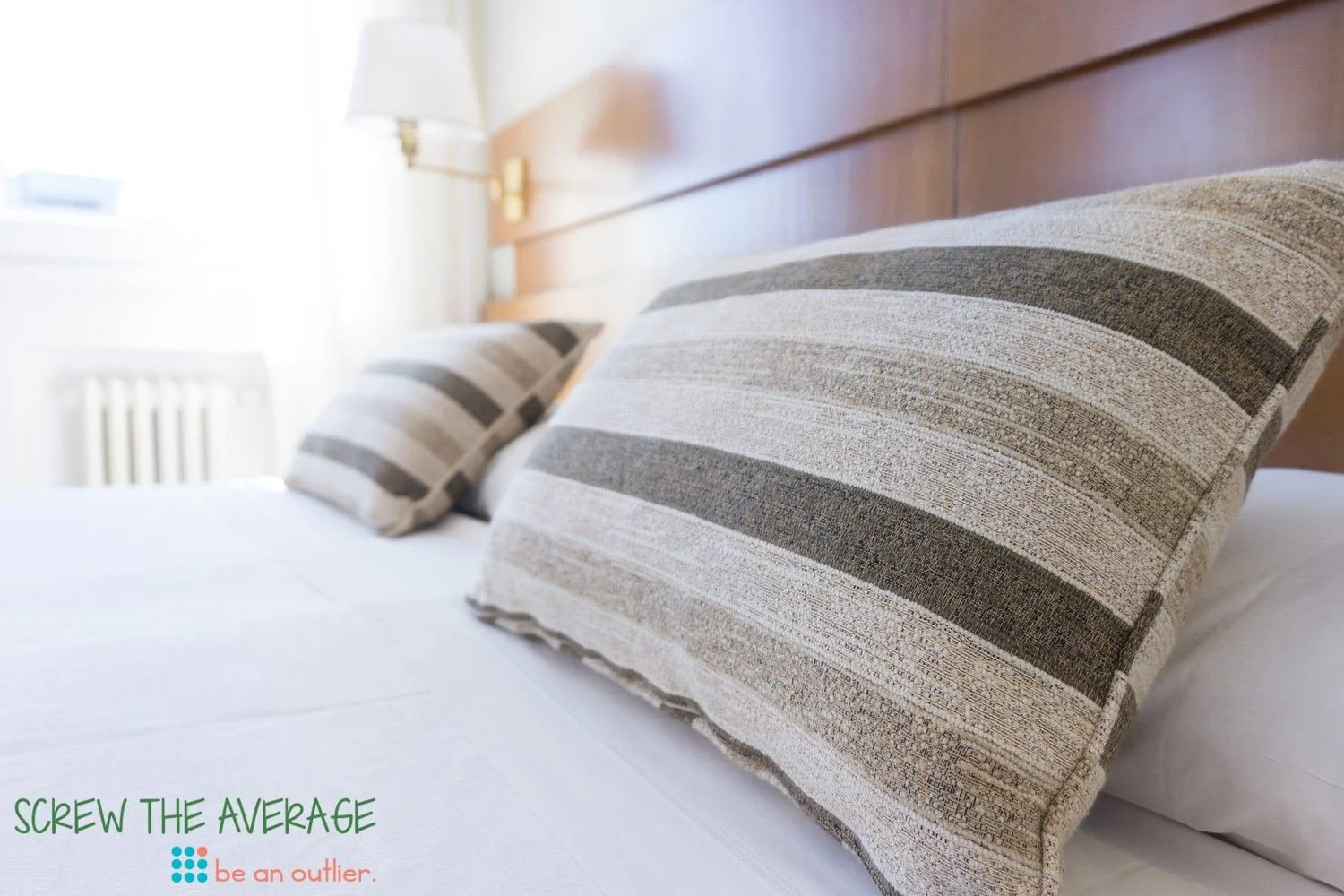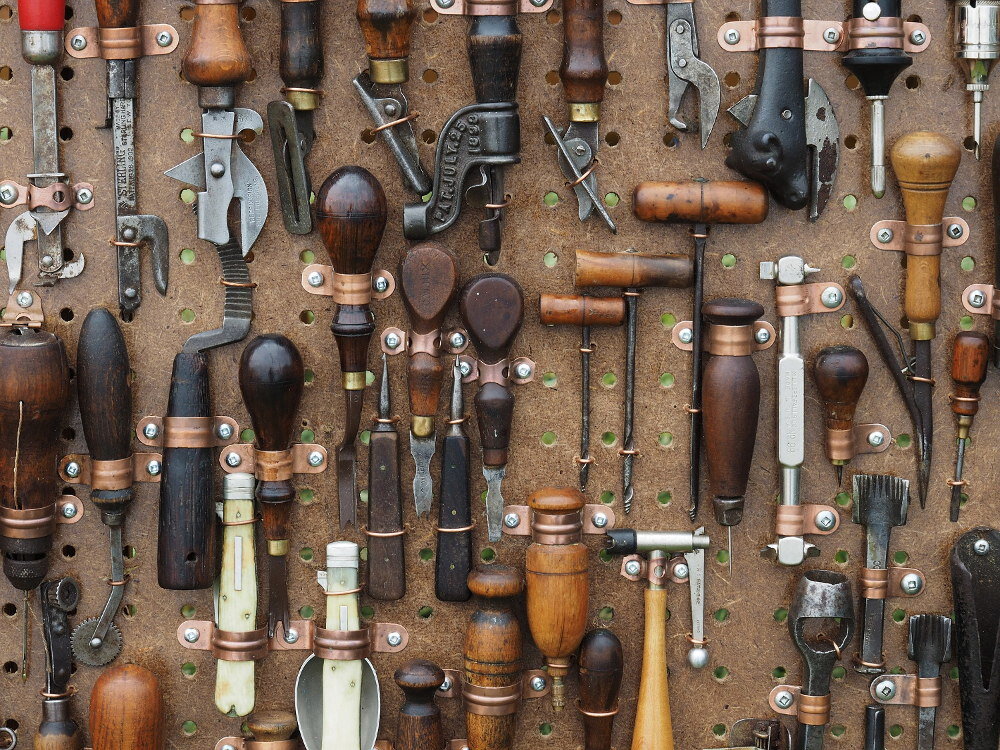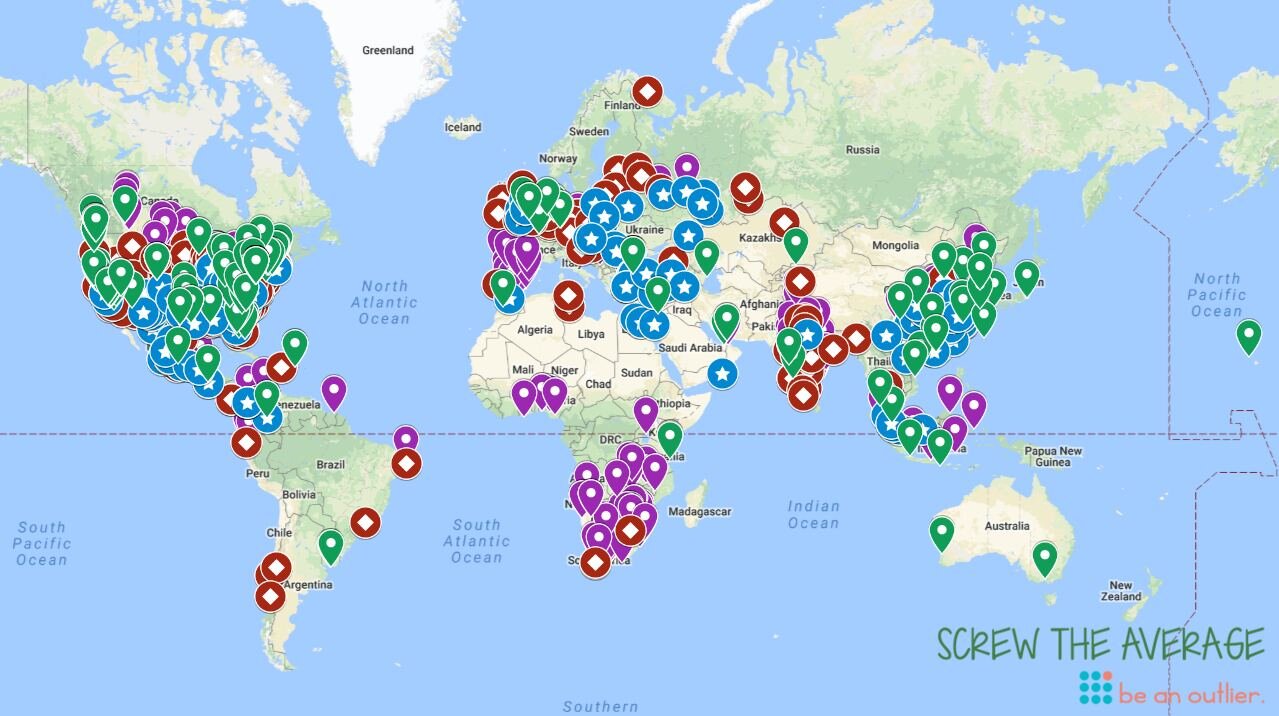DIY – How to Hack $30+ Travel Packing Cubes (2022 UPDATE)
How to make a cheap alternative to store bought packing cubes by making your own DIY Travel Packing Cubes (and reinforcing them if needed), no sewing required! Plus, see our review and what’s worked best after nearly six years of long-term travel as digital nomads across four continents, 26 countries and 100+ cities!
Updated with more images of our packing cubes and our thoughts on them after traveling with them full-time for over six years!
Disclosure: We may receive a commission for links on our blog. You don’t have to use our links, but we’re very appreciative when you do. Thanks again for your support, we hope you find our posts and information helpful!
Don’t miss our Ultimate Gear and Packing Lists! Whether you’re traveling long-term or going on a short vacation, we'll show you how to travel with a single carry-on. We share our packing lists (his and hers!), packing tips, and our favorite gear. Plus, we discuss what we don’t carry and why!
We have a love/hate relationship with retail (store bought) packing cubes!
Love Retail Travel Packing Cubes
Convenience – Simply buy them and enjoy them
Weight – Ultra light versions are awesome
Compartmentalization of our bag – Turns our main compartment into an organized space
Pack More – Compression packing cubes help fit more stuff into our pack
Hate Retail Travel Packing Cubes
Weight – Standard packing cubes weigh our bag down
Cost – Ultralight packing cubes are expensive
Added complexity – If a seam rips or a zipper breaks while we’re on the road chances are we won’t be able to repair (or warranty claim) a retail packing cube.
Fit – Square peg into a round hole (usually)
If you know anything about us, we research, plan, discuss, and then research and plan a bit more. Therefore, to prepare for our long-term travel and digital nomad adventure with just a 36 liter backpack each, we researched online for tips on gear and packing.
A large percent of bloggers we read recommended using packing cubes. The idea is that travel packing cubes organize and compartmentalize your travel bag, allowing you to easily find what you're looking for. Plus, with a better utilization of space and in the case of compression packing cubes, you get the added benefit of being able to fit more stuff within the same space.
With that in mind, we set off on a search to find the best travel packing cubes at the greatest value (Pareto's Principle)…
London, San Francisco, Paris, New York City, Athens and more?! Trusted Housesitters has allowed us to travel the world on a budget, but more importantly given us an opportunity to make new friends and have cute and cuddly companions along the way. Sign up and start your next great adventure!
Retail Packing Cube Options (Not DIY)
Eagle Creek - These are ultra-light, highly rated, but very expensive.
LokSak – Officially, these may not be marketed as packing cubes, but they’re sealable, durable, water resistant, and dust proof. These are also expensive but considering the advantages they have over conventional retail ultralight travel packing cubes, they may be worth it!
Off/Store Brand – (Bagsmart, Veken, Amazon Basics) - In the case of eBay , we found some pretty in-expensive travel packing cubes, but durability and weight is often a gamble. Again, a ‘middle of the road approach’ might be to buy from a reputable seller like Amazon or Ikea.
If you’re wondering how to travel internationally, or simply vacation nearby and not spend a fortune on airfare or hotels, then we’d like to welcome you to the world of ‘travel hacking’. See what credit cards we carry, and how we take full advantage of the points and miles we’ve earned.
Features We Want From Our Travel Packing Cubes:
The best travel packing cubes will be the ones that have all (or most) of the features we're looking for that won't break the bank.
Organization
Durable
Water-resistant
Odor locking
Compressible/Compression
We really like the idea of Eagle Creek Pack-It Specter Cubes. Every time we’re at a travel store, usually REI, we’re drawn to these. However, we can never get past the idea of spending so much on what’s essentially a bag. Plus even if you can get past the cost, they don’t keep smells or moisture in or out, and at least on their standard model, they don’t compress (although they do offer a Specter compression model). So, while we like them, they don’t seem like the best option for us.
After going back and forth, on one of our joint daily walks where we chat, brainstorm, and just clear our heads, it came to us… The ingenious DIY (Do It Yourself) project of making our own packing cubes!
We thought we were being original, but like many things, a quick internet search brought us back to reality. It turns out that Ziploc bags have been used by backpackers for ages as travel packing cubes. Instead, what we decided to do was improve on the idea by increasing the durability of a conventional Ziploc bag, hopefully making it the best travel packing cube!
UPDATE: Nearly 6 years later!
DIY Travel Packing Cube Review
After nearly six years and counting of long-term, ‘onebag’ travel, we’ve adjusted and perfected packing our 36 liter backpacks. We’ve learned best practices for passing through TSA and international airport security, as well as how to best pack for stuffing our backpacks into the smallest of budget airline overhead compartments.
We’ve figured out nearly hassle-free methods of how to pack when we’re staying in a different hotel every night for weeks on end. Check out our The Ultimate Mattress Run | Hacking Hotel Rewards for Free Rooms with Hilton!
We’ve figured out what the essentials are and pared down a stuffed full travel backpack to a backpack with room to spare and that’s five pounds lighter. Moreover, we’ve learned how essential (or not so much at times) travel packing cubes are and how we can best utilize them!
How Our DIY Travel Packing Cubes Have Worked Well
They compress our clothes, saving us valuable space in our bag.
They seal, locking in odors, which in our case have worked particularly well for storing dirty clothes.
They protected our items from damage or wear (e.g. water, dirt, friction). It’s nice knowing that our clean clothes will stay clean and protected from any accidental water, spills, or dirt while in our bag.
They help with our bags compartmentalization and organization. They help us quickly locate needed items and ensure our bags remain tidy.
Our reinforced DIY travel packing cubes with duct tape and the subsequent revised version with simpler and lighter packing tape work well for holding items that need reinforcement, like grooming tools with sharp ends, a can opener, our power strip, and pens, etc.
How Our DIY Travel Packing Cubes Haven’t Worked So Well
Unfortunately, after extended daily use (typically 2-3 months), the DIY packing cubes lose their airtight seal. So, in theory, we lose the ability to compress out DIY travel packing cubes to create more space in our backpack. However, in practice, since the air seeps in so slowly we’re not really inconvenienced by it. Plus, for most people who travel or take vacations a week or two at a time their ‘normal’ usage of DIY travel packing cubes will probably last a year or more, depending on your travel style.
The reinforcing of ALL our DIY packing cubes with duct tape and the subsequent revised version with simpler and lighter packing tape, added mostly unnecessary weight.
With consideration that most of our bags were reinforced with duct tape or packing tape in the beginning, the first thing to fail on our DIY packing cubes were the interlocking seals. After extended daily use (6 months+) the small plastic ribs that interlock eventually peeled off the bags, preventing them from staying closed, not just sealing air tight. This was a complete failure and our travel packing cubes had to be replaced at this point.
Lessons Learned and Improvements Made in Using Travel Packing Cubes
Depending on what we used them for and how often we opened and closed them, our DIY travel packing cubes lasted anywhere from 6 months to over 36 months. And while it’s a big range, even at six months, we think they’re a great value at pennies on the dollar, when the cost is spread across an entire set that can be made with one round of supplies.
We’ve learned that not all of our stuff should be packed in packing cubes, for a variety of reasons:
Our DIY travel packing cubes are square and our travel bags (backpacks) are round. So to utilize our backpack’s space efficiently, we choose to not pack our larger clothing items (pants, jacket, long-sleeve shirt) in packing cubes and instead use those items to fill in the gaps and empty spaces within our backpack. Although again, this is mostly a matter of travel style and bag choice, you may find that you prefer a different approach!
Travel packing cubes, regardless of whether you choose to use DIY or retail versions, add weight to your bags total load, even if you DIY/purchase ‘ultralight’ types. In other words, if packing something in a travel packing cube doesn’t justify the weight, we’ll forgo using it.
Retail packing cubes are usually expensive, certainly much more than DIY travel packing cubes, (depending on brand and features) and specialized variants (i.e. ultralight, compression, etc.) even more so. However, perhaps more importantly, they can take some time to replace especially when you’re jet setting around the globe. On the other hand, plastic sealing bags are relatively inexpensive and can usually be found in a variety of stores all over the world. This makes replacing a DIY packing cube much easier than a retail packing cube, epically a specialty type.
We only reinforce the DIY travel packing cubes that require it. Unless we’re packing items that need the extra durability, we stick to a standard Ziploc-type bag. This saves weight, effort, and money on extra supplies.
Larger, one to two gallon bags work wonderfully as dirty clothes bags and also double as a washing bag for handwashing (soaking, agitating) our clothes in a pinch.
Overall Update Thoughts
Even after nearly six years and counting of long-term travel we still can’t justify spending money on lightweight retail travel packing cubes. Perhaps we’re missing something, but our DIY travel packing cube approach seems to be giving us 80% of the value for a fraction of the cost. With the being said, our biggest gripe is that we have to replace a couple of our bags a year, creating unnecessary waste.
Our tool box is full of resources! From travel hacking to house sitting, digital nomad jobs to privacy and security, financially independent retire early (FI/RE) to entertainment, plus travel hacking (credit cards, miles, points, and rewards), and much much more…
DIY Travel Packing Cubes: Reinforced Ziploc Bags
By using economically priced Ziploc bags, we can reinforce what seems to be their weakest points (seams and the top sealing mechanism) with the 'all incredible' duct tape. If successful, this would result in a travel packing cube that's water-resistant, durable, lightweight, odor containing, compressible, and inexpensive!
DIY Travel Packing Cube How To (No Sew!): Version 1.0
This is our first version and what we used when we first started traveling. Version 1.0 is heavy duty and gets the job done. However, we recommend checking out our notes on how we tweaked our DIY travel packing cubes after months of use (version 2.0).
Materials:
Ziploc Bags (choose your size(s): snack, sandwich, quart, one gallon, two gallon)
Clear Packing Tape (used in Version 2.0)
Measuring tape
Instructions:
Follow along by your preferred method! Watch the DIY Travel Packing Cube Video Tutorial for a detailed walk-through or follow the written instructions below.
Measure and cut your tape to the length of the bottom of the bag, adding an additional 1-1.5 inches to each side.
Lay the tape flat on your working surface.
Apply the bottom of the Ziploc bag to the tape: center the bag to the length of the tape and only apply half of the width of the tape (you’ll fold over half of the tape to the other side of the bag in step 6).
Cut out the corners of each side of the tape (the 1-1.5 inch of excess tape left on each side). This prevents excess hangover, think gift box wrapping.
Fold in each side of tape on to the bag.
Fold over the bottom of the tape to the opposite side of the bag.
Cut two pieces of tape equal to the length of the height of the bag.
Apply each piece of tape to each side of the bag, horizontally, with half on one side of the bag.
Fold over the tape to the other side of the bag.
Cut a piece of tape equal to the width of the bag and apply to the top of the bag on or below the zipping/seal mechanism of the bag.
Pat yourself on the back, you’re done!
DIY Travel Packing Cube How To (No Sew!): Version 2.0
First, thanks to everyone for your comments and feedback! Between your clever points and our real world use, we’ve since updated a few things:
Duct tape is opaque (DUH!), so it doesn’t always play well with TSA and other inspection agents. Our new 2.0 DIY travel packing cube bags are reinforced on their edges with strong clear packing tape only. This insures that inspection agents can see completely through the bag and noticeably cuts down on weight.
Our DIY travel packing cubes started to show tears and stretching on all areas of the bags. So even though the weakest points seem to be the edges and seams, we also see plenty of value in lining the rest of the bag with clear packing tape, including taping over the seal/zipping mechanism of each bag.
Our backpacks (Osprey Manta AG 36 and review) are round but our DIY travel packing cubes are square. This equals wasted space in our packs! Our conclusion is that while we initially were packing all of our stuff in these packing cubes, we’re now only packing select items in them. Here’s how we’re packing now:
Don't miss our ultimate gear and packing list to see how we have room to spare in our OneBag 36L backpacks and how we stay around 15 pounds (7 kg)!
DIY Travel Packing Cube Tips and Additional Thoughts:
Sharp scissors will make your life so much easier when trying to complete this project. If you don’t have brand new, super sharp scissors, try cutting with the part of the scissors where the two blades join for an easier cut.
Clean your scissors. As you work through reinforcing your DIY packing cubes, periodically clean your scissors using a bit of rubbing alcohol or hand sanitizer and a napkin (or sanitizing wipes). The tape tends to leave a sticky residue on the scissor blades that builds up over time and causes more difficulty and less sharp cuts over time.
Patience! As with most DIY projects, patience is key. All the videos and tutorials make DIY projects look so easy. However, they’re usually more challenging than they look. Cutting the tape to the right length, applying it without ripples and bubbles, and getting it straight can be challenging. Take your time and soon enough you’ll be doing this project like a pro. Perfection is overrated, remember Pareto’s Principal, 20% of the effort will get you 80% of the results. Begin with the end in mind and focus on your ultimate purpose: reinforcing your DIY packing cubes. Your first bag will most likely look like a sad/comical version of your last bag.
TIP: During our initial gear and packing research, we noticed that long-term travelers and digital nomads recommended plugging up a sink with a drain stopper to wash our clothes. However the idea of packing a drain stopper wasn't appealing. So when we heard a suggestion to use a large LokSak bag to wash clothes in, we realized that we could do the same thing with a large two gallon Ziploc bag. We love this idea since it’ll leave the sink free, allow for easier washing (think shaking/whooshing like a washer) and you don’t have to worry about the cleanliness of random sinks. To top it off, the same bag doubles as our dirty laundry bag!
For those of you that prefer a commercial of the shelf wash bag, you can use the Scrubba. We haven’t tried one yet, but it's a no-hassle off the shelf alternative, and at 0.31 lbs (five ounces), it’s relatively light weight.
Final Thoughts
Whether we're talking retail travel packing cubes or DIY travel packing cubes, there are pros and cons to consider. It's important to look at what you're packing, the shape of your bag, and your travel style, to determine which method will work best for you. When we consider how many individual Ziploc bags and tape, we can purchase for the cost of just one retail packing cube, the choice between retail and DIY is clear for us.




















